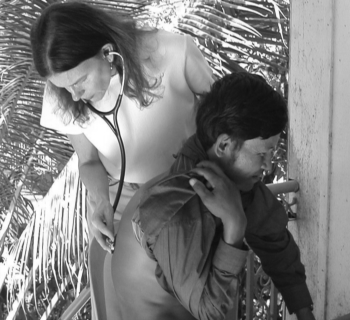Taking on Two Diseases in Cambodia
An innovative program hopes to halt the destructive interaction between TB and HIV
April 2004—Cambodia has the highest rate of HIV infection in Southeast Asia, accompanied by one of the world’s highest incidences of tuberculosis. Working together, the two diseases are increasing mortality rates and depleting what should be a healthy workforce. In remote villages and patients’ homes in Svay Rieng Province, the Cambodian Health Committee (CHC), with support from TREAT Asia, is working to break the cycle.
Cambodia’s AIDS epidemic—2.7 percent of people ages 15-49 are HIV positive and almost none have access to treatment—began in the early 90s, fueled by a rapidly growing commercial sex industry. Patients presenting with tuberculosis were some of the first to be diagnosed with AIDS.
In the developing world, one of the early warning signs of an AIDS epidemic is a sharp rise in TB diagnoses. As patients progress from HIV infection to AIDS, their bodies are less able to mount a defense against tuberculosis. In another destructive turn of events, TB wreaks havoc with immune cells, propelling HIV viral loads higher and putting patients at greater risk for the opportunistic infections that accompany AIDS. In Cambodia, where the World Health Organization puts the prevalence of TB as high as 64 percent, the disease accounts for half of all AIDS deaths.

Dr. Anne Goldfeld examines a patient in Svay Rieng Province, Cambodia. |
“What you see in Cambodia,” said Dr. Anne Goldfeld, Associate Professor of Medicine at Harvard University and a co-founder of the CHC TB program, “is all these young people in the prime of life dying of AIDS. It’s heartbreaking to be 20 years into the epidemic and see what should be a young, healthy generation dying needlessly.”
To halt the interaction of HIV and TB, the CHC, with support from the Cambodian Ministry of Health and the National Center for HIV/AIDS, Dermatology, and STDs (NCHADS), is building upon a successful TB treatment program begun in 1994 that has cured more than 4,000 tuberculosis patients and achieved a 95 percent rate of treatment compliance and cure among villagers in the Southeast province of Svay Rieng.
By visiting patients in their homes, engaging patients’ families and communities, training village health workers, and creating a linked microfinance program, the CHC successfully treats patients and diagnoses 500 new cases of TB a year. Five percent of those patients are also infected with HIV.
Sok Thim, who co-founded the program with Dr. Goldfeld and served as executive director from 1994 to 2000, credits the program’s success with face-to-face patient interaction.
“I show the patients how much I love and care for them by being there when they need me, and I always respect patients’ dignity,” said Thim. “Our program is based on the belief that no matter how poor they are, everyone wishes to be well, if provided a chance.” Thim will only hire staff as committed as he is.
Through a grant from the Pfizer Foundation, TREAT Asia is partnering with the CHC and the Svay Rieng hospital to train health care workers to administer desperately needed antiretroviral (ARV) therapy in tandem with TB treatment. The CHC is also being supported by the Comprehensive International Program of Research on AIDS and Agence Nationale de Recherches sur le Sida. Applying the lessons learned from administering TB drugs, the program’s goal is to achieve a similar compliance rate for ARV medication.
Successful treatment in village settings is critical to eliminating TB and reducing the harm that AIDS is inflicting on Cambodia, said Dr. Goldfeld. More than three quarters of Cambodia’s population live in rural areas. Many people cannot travel to cities to seek treatment and those who do are often worse off for having tried and failed. “Right now, the possibility of antiretroviral treatment draws people to Phnom Penh,” said Goldfeld. “Once they are there, they have no support systems, end up homeless, and then die, leaving orphans behind them.”
Patients who make the journey usually wind up at one of Cambodia’s most overburdened medical facilities—the pulmonary ward at Preah Bath Norodom Sihanouk Hospital (PBNSH). The pulmonary ward is often a last resort for patients with AIDS and tuberculosis who have traveled long distances in the hope of finding treatment. What they find instead is a cramped and dilapidated space where patients sleep on floors, family members are relied upon to supply food and medicine, and nursing and physician staff are overworked and not trained to treat HIV/AIDS.
A second component of the CHC’s program will be to provide much-needed infrastructure improvements, training, and medicines at PBNSH. The CHC will collaborate with Médecins Sans Frontières-France, which has created a center of excellence in AIDS care and ARV provision in the infectious disease ward at PBNSH. The CHC will train health care workers to administer ARVs and treat other common opportunistic infections associated with AIDS, increase financial support for physicians (enabling them to leave private practice and focus on treating patients in the ward), and increase support for people living with AIDS through a hospice program already established by the Maryknoll Missionaries.
With support from NCHADS, the CHC has already begun limited distribution of ARVs in Svay Rieng and will continue to expand the program over the coming year. “Our goal,” said Goldfeld, “is to decrease the suffering caused by AIDS and HIV. We want to pioneer models of care applicable in other settings in Asia and resource-poor countries around the world.”